Until the beginning of the industrialisation, timber was the most important commodity, used in many different domains.
Production of wood charcoal
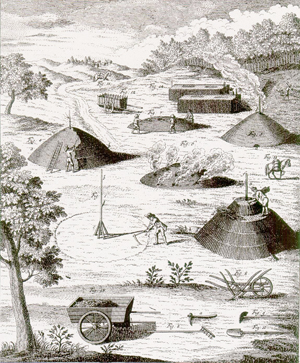 The charcoal production supplied the forges and metallurgical plants. Already the metallurgical site of Dommeldange needed for itself about 6000 steres of timber per year. In a document, addressed to the Chambre des Comptes in the year 1740, a complaint was formulated because there was apparently no timber wood anymore left in the Grünewald. All the wood had been used as firewood or transformed into charcoal. It is only in 1865, when the coke began to replace the charcoal, that the excessive exploitation of the Grünewald took an end.
The charcoal production supplied the forges and metallurgical plants. Already the metallurgical site of Dommeldange needed for itself about 6000 steres of timber per year. In a document, addressed to the Chambre des Comptes in the year 1740, a complaint was formulated because there was apparently no timber wood anymore left in the Grünewald. All the wood had been used as firewood or transformed into charcoal. It is only in 1865, when the coke began to replace the charcoal, that the excessive exploitation of the Grünewald took an end.
Timber and firewood
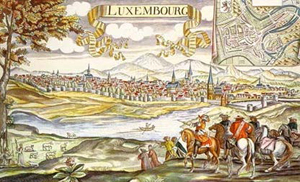 Not only the construction of the Luxembourg fortress but also its exploitation needed huge quantities of firewood and timber and for a certain time the Grünewald had only been used for the supply in firewood purpose.
Not only the construction of the Luxembourg fortress but also its exploitation needed huge quantities of firewood and timber and for a certain time the Grünewald had only been used for the supply in firewood purpose.
Potash factory
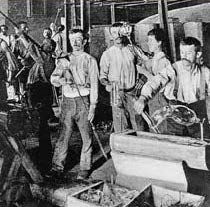 The potash manufacturers produced the potash as ingredient of soap and glass.
The potash manufacturers produced the potash as ingredient of soap and glass.
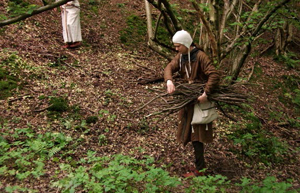
During centuries the Grünewald was the main supplier in firewood.
The massive wastage of wood asked for an early and precise scheduling of forest management. Already in the Middle Ages they tried to slow down the wild exploitation of the forests. In 1617 an edict with 125 different subjects about forest use and authorizations management in our region was issued by the Dutch/Spanish sovereigns, the Archduke Albert and the Archduchess Isabella. The strategy of timber supply let to a definitely regular forestry system with the principle of sustainability, still valid nowadays.
Permissions to collect the wood
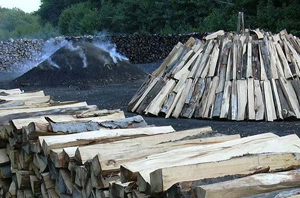 During centuries the monarchs owning the Grünewald had the right to exploit the wood, later they granted these same rights to their subjects by the so-called permissions to collect the wood.
During centuries the monarchs owning the Grünewald had the right to exploit the wood, later they granted these same rights to their subjects by the so-called permissions to collect the wood.
Already in the year 1270, count Henri V granted to the monastery of the “Saint Esprit de Luxembourg” the right to remove every day the windfall of his property Andevane, by means of a one horse-drawn cart. On August 13th, 1320, Jean the Blind granted to the order of the Clergymen as well as to the order of the Franciscans, but this at an unknown date, permissions to collect the wood in the Grünewald.
Permissions to collect the wood were also delivered to the monastery of the “Saint Esprit de Luxembourg” (22.11.1384), to the abbey of Münster (21.05.1398), to the Order of Friars Minor (in 16.10.1473), to the inhabitants of Luxembourg, Hollerich and Bonnevoie (in 14.12.1480) and to the order of the Jesuits (in 06.09.1609).
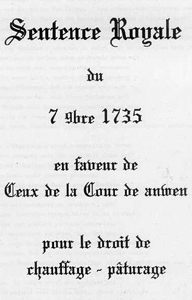
The last inscription about the usage rights of the Anwen Farm in the Grünewald can be found in the “Sentence Royale” dated 7 November 1735. But already in 1362 those rights were regulated by the “Weistum” of the Anwen Farm.
In the “Royal Judgment” of November 7th, 1735 permission to exploit pastures and to collect firewood was granted to the court Anwen. But the devastation in the forests constantly gave rise to complaints. This is why Ferdinand d’Espagne, brother of the king of Spain Philippe IV, ordered January 18th, 1638, to end the rights of monasteries as well as of all authorized people in the Grünewald because the forest was being destroyed.
Under the Austrian reign, the archduchess Marie-Thérèse ordered to the Minister Marquis de Botta to make an analysis of the state of its forests. She tried to obtain in this way an improvement in national forests “because these suffered a lot from an excessive exploitation and from a failure to respect the laws “.
Until the middle of the 19th century, the permissions to collect wood were important in the Grünewald and were liquidated little by little by refunds in the shape of money or of grounds. So, in the year 1846, the municipalities of Niederanven, Steinsel and Eich informed the government that they were inclined to transfer their rights in national forests for the price of 50-franc ha. On January 25th, 1847, this offer was accepted by the government and granted by the king-grand duke.
